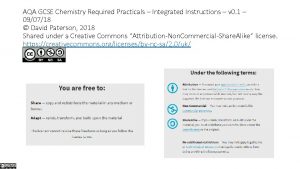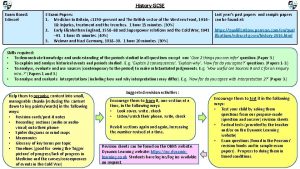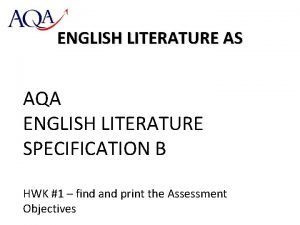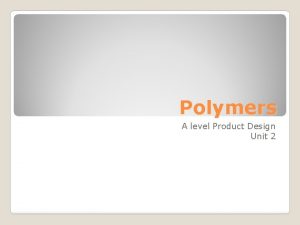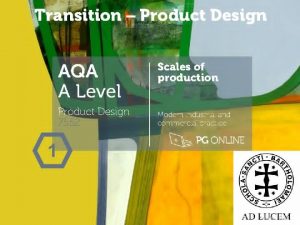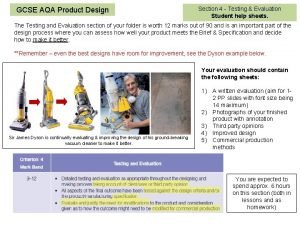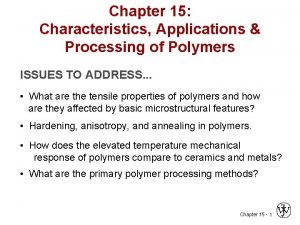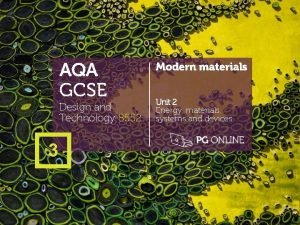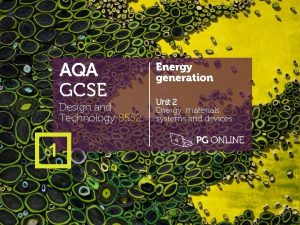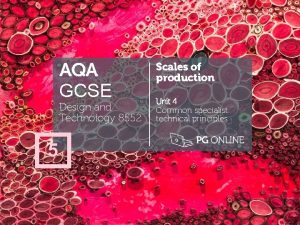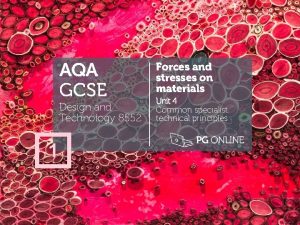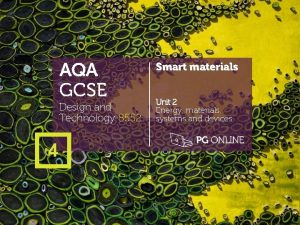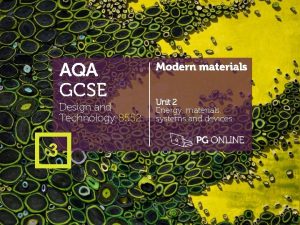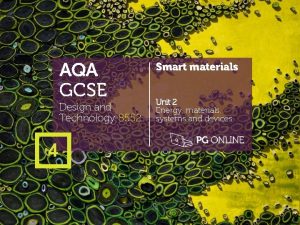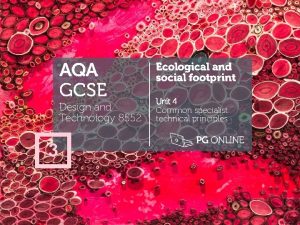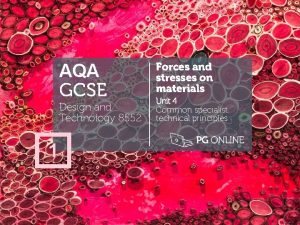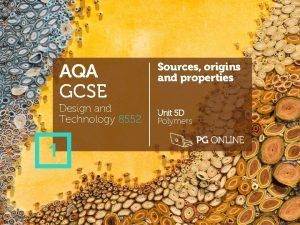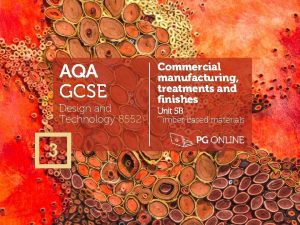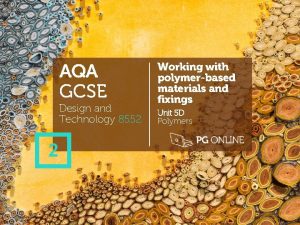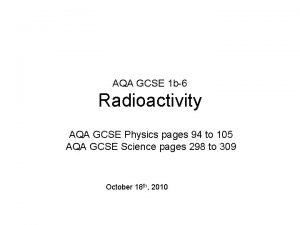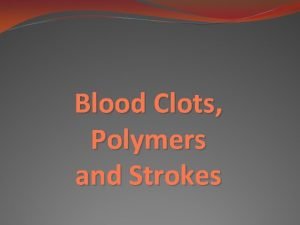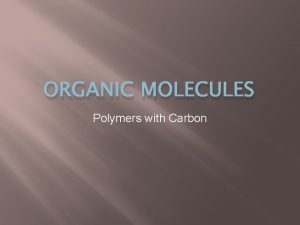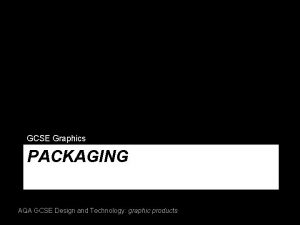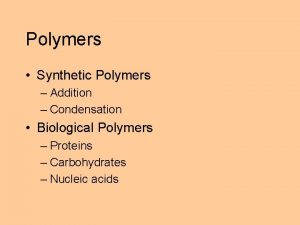AQA GCSE Design and Technology 8552 4 Polymers


























- Slides: 26

AQA GCSE Design and Technology 8552 4 Polymers Unit 3 Materials and their working properties

Objectives • Know the primary sources of materials for producing polymers • Be able to recognise and characterise different types of polymers • Understand how the physical and working properties of a range of thermoforming and thermosetting polymers

Polymers Unit 3 Materials and their working properties The age of plastic • For more than 50 years, the global production and consumption of plastic has continued to rise • Approximately 300 million tons of plastic is produced each year • Plastic is relatively inexpensive to produce and very versatile • Name a range of products you have used today that have been made from plastic and try to identify their properties

Polymers Unit 3 Materials and their working properties What are polymers? • Polymers are mostly synthetic materials • They are usually derived from finite resources such as coal, natural gas or crude oil • More renewable and sustainable materials such as vegetable starches are being used to make bio-plastics • What are the benefits of sourcing natural materials?

Polymers Unit 3 Materials and their working properties Plastic categories • Plastics are categorised into two types: Thermoforming Thermosetting Also known as thermoplastics, when heated the plastic becomes soft and flexible Also known as thermosets, this plastic cannot be reformed once set in to shape Thermoplastics can be remoulded without affecting the material’s physical properties Thermosets have strong chemical bonds between the molecules, which do not separate on heating

Polymers Unit 3 Materials and their working properties Molecular structure Thermoforming plastics Thermosetting plastics Long chains of loose molecules that have no fixed structure or pattern Individual monomers join to form a large polymer. These long chains of molecules are cross linked resulting in a rigid molecular structure

Polymers Unit 3 Materials and their working properties Thermoplastic pros and cons • Thermoplastics can be repeatedly heated and moulded • Thermoplastics are not suitable for use in areas of heat or UV sensitivity • A good surface finish can be achieved for superior aesthetics • They can be recycled • Each time the plastic is reheated it will try to return to its original shape – this is known as plastic memory • What are the benefits of reusing plastics?

Polymers Unit 3 Materials and their working properties Thermosets pros and cons • Thermosets are hard and durable with good structural rigidity • They are: • able to withstand higher temperatures • waterproof when solid, so ideal for use in adhesives • a good electrical insulator • cannot be remoulded

Polymers Unit 3 Materials and their working properties Worksheet • Complete Task 1 of your worksheet

Polymers Unit 3 Materials and their working properties Moulding and forming • Plastics can be formed using a variety of processes • Blow moulding – forming hollow plastic items • Extrusion – creating objects with a cross section profile • Injection moulding – injecting softened plastic into a mould • Vacuum forming - sheet of softened plastic forced onto a mould • Which process has been used for the following items?

Polymers Unit 3 Materials and their working properties Polyethylene • This is the most common thermoplastic with over 80 million tonnes produced globally each year • There are several types of polyethylene including • Polyethylene terephthalate (PETE) • High density polyethylene (HDPE) • Low density polyethylene (LDPE) • Polyethylene can be rigid with good strength to weight ratio • It has good ductility and impact strength • Its stability makes it a suitable plastic for blow-moulding

Polymers Unit 3 Materials and their working properties Uses of polyethylene • Suggest two other items that may be made from each of the different types of polyethylene Polyethylene terephthalate High density polyethylene Low density polyethylene Lightweight, chemically resistant, stable, easily blow moulded Lightweight, rip and chemical resistant, stiff and resists cracking Flexible, tough, high strength to weight ratio, easily extruded into sheets

Polymers Unit 3 Materials and their working properties Polyvinyl chloride • PVC is widely used for packaging, pipes, outerwear, electrical tapes and children’s toys • PVC can be rigid and commonly used for making pipes • It is tough and easily extruded • With the addition of plasticisers, it becomes flexible • What makes PVC suitable for sports equipment?

Polymers Unit 3 Materials and their working properties Polypropylene • A very versatile polymer, polypropylene is used for solid plastics, films and fibres • It has low density, making it lightweight • It is ductile, enabling it to stretch for use in fibres and films • It’s chemically resistant and easily cleaned which makes it very suitable for food containers • Which types of food packaging would PP film be suitable for?

Polymers Unit 3 Materials and their working properties High Impact Polystyrene • HIPS is shatterproof and a good insulator • It’s flexible and lightweight so ideal for vacuum forming • Impact resistant, it is suitable for food containers particularly yoghurt pots and fast food containers • HIPS is easily mouldable and has a good gloss finish • What other items would be suitable to be made from HIPS and why?

Polymers Unit 3 Materials and their working properties Acrylic Polymethyl. Methacrylate • This versatile and hard wearing plastic, comes in a variety of thicknesses and colours • It’s a tough plastic, but becomes brittle if very thin • It can also be spun into threads and woven • Name some items of clothing that may utilise acrylic?

Polymers Unit 3 Materials and their working properties Resin identification codes • Thermoplastics must be recycled separately to enable reuse, where possible • In order to easily separate items, thermoplastics are marked with a common code Polyethylene terephthalate High-density polyethylene Polyvinyl chloride Low-density polyethylene Polypropylene Polystyrene Other plastics, such as acrylic, nylon and polycarbonate

Polymers Unit 3 Materials and their working properties Epoxy resin • Epoxy resins are a class of reactive polymers • Supplied as two liquids; a resin with a hardener which acts as a catalyst to set the resin • Epoxy resins are used as adhesives, for example Araldite® • With a good strength to weight ratio, epoxy adheres well to fibreglass and carbon fibre, reinforcing it • What protective measures should you take when working with epoxy resin?

Polymers Unit 3 Materials and their working properties Polyester resin • Polyester resin is a viscous, pale polyester solution and the addition of a catalyst, hardens the resin • The hardened resin is tough with high abrasion resistance which makes a high-performance coating for areas of high wear, for example flooring • Clear polyester resin is suitable for object embedding, clear sculpture casting and jewellery making • Resin replicas e. g. anatomical models can also cast be cast and painted

Polymers Unit 3 Materials and their working properties Composite adhesive • Polyester resin is commonly used with composite materials such as fibreglass • Lightweight and weatherproof, it’s used to adhere layers of fibreglass in the making of boat hulls, vehicle parts and panels for caravans

Polymers Unit 3 Materials and their working properties Formaldehyde • An early compound, thermoset products made using formaldehyde include: • Melamine formaldehyde • Phenol formaldehyde • Urea formaldehyde • Phenol formaldehyde (created in 1909) was known as Bakelite • Very rigid and hard, it was often used for electrical components and household items such as clocks, radios and telephones

Polymers Unit 3 Materials and their working properties Melamine formaldehyde • Melamine is a hard thermoset • A heavy material, it has good resistance to heat, chemicals and moisture • It has good resistance to scratches, but it is prone to chipping • Available in a range of colours and thicknesses, it is often used for picnic wear and as a laminate for kitchen surfaces • What will happen if you put your melamine bowl in the microwave?

Polymers Unit 3 Materials and their working properties Urea formaldehyde • Urea formaldehyde is a good electrical insulator • With good heat resistance it is used for manufacturing electrical fittings • The textiles industry treats some fabrics with UF resins to promote easy care properties such as anti-wrinkling • The paper industry uses UF to improve tear strength • The timber industry uses UF resin to bind particles in the making of manufactured boards such as MDF

Polymers Unit 3 Materials and their working properties Worksheet 3 • Complete Tasks 2 – 5 of the worksheet

Polymers Unit 3 Materials and their working properties Plenary • State the two categories of plastics • Name one finite resource from which polymers are derived • What is the most environmentally effective way of disposing of plastic? • Suggest a plastic with good electrically insulative properties • Name two plastics suitable for food packaging

Polymers Unit 3 Materials and their working properties Copyright © 2017 PG Online Limited The contents of this unit are protected by copyright. This unit and all the worksheets, Power. Point presentations, teaching guides and other associated files distributed with it are supplied to you by PG Online Limited under licence and may be used and copied by you only in accordance with the terms of the licence. Except as expressly permitted by the licence, no part of the materials distributed with this unit may be used, reproduced, stored in a retrieval system, or transmitted, in any form or by any means, electronic or otherwise, without the prior written permission of PG Online Limited. Licence agreement This is a legal agreement between you, the end user, and PG Online Limited. This unit and all the worksheets, Power. Point presentations, teaching guides and other associated files distributed with it is licensed, not sold, to you by PG Online Limited for use under the terms of the licence. The materials distributed with this unit may be freely copied and used by members of a single institution on a single site only. You are not permitted to share in any way any of the materials or part of the materials with any third party, including users on another site or individuals who are members of a separate institution. You acknowledge that the materials must remain with you, the licencing institution, and no part of the materials may be transferred to another institution. You also agree not to procure, authorise, encourage, facilitate or enable any third party to reproduce these materials in whole or in part without the prior permission of PG Online Limited.
 Gcse art and design aqa
Gcse art and design aqa Aqa design and technology past papers
Aqa design and technology past papers Gcse pe 9 marker structure
Gcse pe 9 marker structure Gcse geography edexcel b revision checklist
Gcse geography edexcel b revision checklist Aqa history paper 1
Aqa history paper 1 Aqa chemistry gcse required practicals
Aqa chemistry gcse required practicals Aqa religious studies gcse 2020 paper
Aqa religious studies gcse 2020 paper Anticipating misuse computer science
Anticipating misuse computer science Aqa gcse physics
Aqa gcse physics Gcse history past papers edexcel
Gcse history past papers edexcel Trigonometry questions gcse aqa
Trigonometry questions gcse aqa Aqa maths gcse revision guide
Aqa maths gcse revision guide 12 mark question history
12 mark question history Kendal industrial park aqa
Kendal industrial park aqa Aqa gcse english literature specification
Aqa gcse english literature specification Sample design and technology gcse examination paper answers
Sample design and technology gcse examination paper answers Sample design and technology gcse examination paper answers
Sample design and technology gcse examination paper answers Www.technologystudent.com
Www.technologystudent.com Sample design and technology gcse examination paper answers
Sample design and technology gcse examination paper answers Gcse design and technology coursework examples 2019
Gcse design and technology coursework examples 2019 Ocr gcse dt
Ocr gcse dt Polymers product design
Polymers product design Aqa a level art and design
Aqa a level art and design Art and design a level aqa
Art and design a level aqa Aqa product design
Aqa product design Aqa product design specification
Aqa product design specification Application and processing of polymers
Application and processing of polymers





